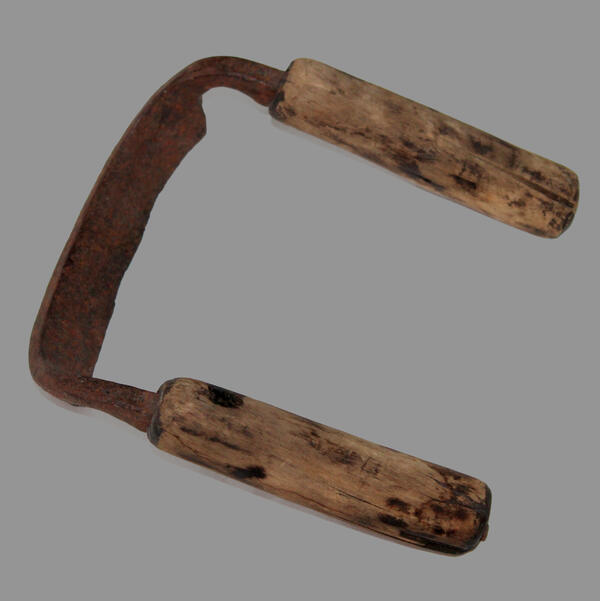In the 1930s, during active construction in the oil village of Ishimbaevo, workers often used drawknives. The drawknife is an ancient carpentry tool that consists of a straight or curved blade with handles at each end, and is designed for debarking logs, as well as for their initial rough dressing. There are two main types of drawknives – the curved and the straight blades, – while the collection of the Ishimbay Museum contains an example of the in-between variant: the semi-curved drawknife.
The drawknife was often used for debarking logs when felling trees: it allowed to peel bark at the edge of the bast without damaging the wood itself, while at the same time smoothing out the log’s surface, as well as shaving off any irregularities and small knots. Wood becomes light in color when treated with a drawknife, and all traces of bark are completely removed from its surface. That is why, for example, the walls of a log house that have been treated with a drawknife do not require any additional sheathing or finishing, and display the wood’s natural beauty.
During debarking, the removal of bark, the drawknife is drawn from the wider part of the tree trunk, the butt end, towards the top, so as not to leave any irregularities or jagging on the wood’s surface. When using an axe for debarking, the carpenter is very likely to chip or notch the wood. Not only does it ruin the wood’s appearance, but also increases the chance of its infection and, consequently, the deterioration of its properties. Conversely, logs with a solid, dense, and smooth surface can last remarkably long.
Drawknives were also used for removing wavy irregularities left on hewn surfaces after they had been treated with an axe, as well as for bringing the smoothness of wood surfaces to perfection. With its help, carpenters planed walls, roofing boards, doors, shutters, as well as door and window frames. Such structural elements were only planed in small quantities to be used for interiors of homes or churches, as drawknives are very difficult to work with, significantly more difficult than hand planes.
Straight surfaces were treated with straight drawknifes, while curved blades was used for round corners. Door and window frames, doors, boards and other similar structural elements were planed along the grain, while walls were planed at an angle of about 60 degrees relative to the log’s surface. Since the logs used for walls had sloping grain, they were planed in two directions, with one half of the log being planed in one direction, and the other half in another. Once it was planed with a drawknife, the surface required no additional treatment.
The drawknife was often used for debarking logs when felling trees: it allowed to peel bark at the edge of the bast without damaging the wood itself, while at the same time smoothing out the log’s surface, as well as shaving off any irregularities and small knots. Wood becomes light in color when treated with a drawknife, and all traces of bark are completely removed from its surface. That is why, for example, the walls of a log house that have been treated with a drawknife do not require any additional sheathing or finishing, and display the wood’s natural beauty.
During debarking, the removal of bark, the drawknife is drawn from the wider part of the tree trunk, the butt end, towards the top, so as not to leave any irregularities or jagging on the wood’s surface. When using an axe for debarking, the carpenter is very likely to chip or notch the wood. Not only does it ruin the wood’s appearance, but also increases the chance of its infection and, consequently, the deterioration of its properties. Conversely, logs with a solid, dense, and smooth surface can last remarkably long.
Drawknives were also used for removing wavy irregularities left on hewn surfaces after they had been treated with an axe, as well as for bringing the smoothness of wood surfaces to perfection. With its help, carpenters planed walls, roofing boards, doors, shutters, as well as door and window frames. Such structural elements were only planed in small quantities to be used for interiors of homes or churches, as drawknives are very difficult to work with, significantly more difficult than hand planes.
Straight surfaces were treated with straight drawknifes, while curved blades was used for round corners. Door and window frames, doors, boards and other similar structural elements were planed along the grain, while walls were planed at an angle of about 60 degrees relative to the log’s surface. Since the logs used for walls had sloping grain, they were planed in two directions, with one half of the log being planed in one direction, and the other half in another. Once it was planed with a drawknife, the surface required no additional treatment.



